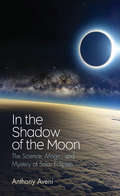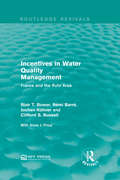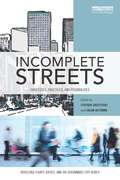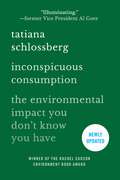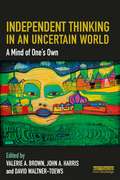- Table View
- List View
In the Name of Sharks
by François SaranoTwenty metres below water, the oceanographer François Sarano came face to face with a five-and-a-half metre great white shark. Seduced by the gentle elegance of this majestic creature, Sarano experienced a profound sense of affinity with her as they swam side by side, shoulder to shoulder, eye to eye, cutting a single figure through the ocean depths. It was an experience which made him realize the depth of our ignorance of the lives of sharks, leading him to become a passionate advocate for their protection. Drawing on the latest scientific research on the biology and ethology of sharks and their exceptional characteristics, this book aims to break through the barrier of prejudice and to pay homage to their true nature. Representing a last vestige of wildness, their populations are nevertheless under threat – like so many species, they have been hunted and exploited by humans. Sarano argues for a change of mindset in which we lose ourselves in the world of the other, so that each living entity, human and non-human, can take their rightful place in the broader global ecosystem.
In the Search of the Lost Pearl: Rediscovery of Southern Populations of Margaritifera margaritifera (L.) in Russia as a Model of Conservation Research
by Igor PopovThe monograph focuses on the European freshwater pearl mussel Margaritifera margaritifera, which is an endangered bivalve species. Most of its populations in the Russian section of the Baltic Sea basin had never been studied, although they were known in the past to the pearl fishers. “Rediscovery” included search for the previously unknown populations, revealing the facts of population extinctions, analysis of negative impacts, elaboration of conservation measures, and revealing of regularities in distribution. Patterns of land use and river management were analyzed. The procedure of “rediscovery” was applied for other animal species of Northwest Russia, which are threatened on a global scale – thick-shelled mussel, Unio crassus; curlew Numenius arquata; black-tailed godwit, Limosa limosa; Northern Lapwing, Vanellus vanellus; European mink, Mustela lutreola; pond bat, Myotis dasycneme; Atlantic sturgeon, Acipenser sturio; and broad-clawed crayfish, Astacus astacus. The methods and principles of conservation studies were discussed. The obtained data were analyzed with respect to current global change of biosphere. The book will appeal to specialists dealing with conservation studies and activities such as red lists, river protection, and conservation of endangered species. Moreover, a part of the book represents an interest for biogerontology as it presents discredit of the popular concept on “negligible senescence.” The data on distribution of some animals in Russia will be interesting in terms of zoology and biogeography, as they are not yet sufficiently represented in the international editions. The book can be used as supplemental reading for courses in biological invasions, ecology and conservation, and biodiversity. The work also contains chapters on global processes (deforestation, desertification, river degradation) and can therefore also be used for general courses in environmental sciences.
In the Shadow of Ben Nevis
by Ian SykesIn 1959, sixteen-year-old Ian ‘Spike’ Sykes left school and, after a short period of work at Leeds University, joined the RAF. Already a keen climber, he signed up on the promise of excitement and adventure and was posted to the remote RAF Kinloss Mountain Rescue Team in the north of Scotland. It was the beginning of a journey which would see him involved in some of the most legendary call-outs in Scottish mountain rescue history, including the 1963 New Year tragedy on the Isle of Skye. In the Shadow of Ben Nevis tells Spike’s story from growing up in Leeds in the aftermath of the Second World War, to his time with the RAF during the cold war. After leaving the RAF, he remained an active member of the Lochaber Mountain Rescue Team and was involved in the first lower down the north face of Ben Nevis - an epic 1,500-foot descent to rescue stricken climbers in the middle of winter. Following a two-and-a-half-year stint on Antarctica with the British Antarctic Survey, he returned to the Highlands and opened the first Nevisport shop with his close friend Ian ‘Suds’ Sutherland. Together, they brought Sunday trading to Fort William and were one of a small number of shops to revolutionise outdoor retail in the UK. Later, he was a key player in the development of the Nevis Range ski area. Over many years, and against all odds, the project became a reality and a great success. Recounted within these pages are a great many lively tales of adventures and mishaps, told with immediacy and charm. With a foreword by legendary Scottish mountaineer Hamish MacInnes, a close friend of Spike’s, In the Shadow of Ben Nevis is a must-read for anyone with an interest in Scottish mountaineering and mountain rescue.
In the Shadow of the Moon: The Science, Magic, and Mystery of Solar Eclipses
by Anthony AveniIn anticipation of solar eclipses visible in 2017 and 2024, an exploration of the scientific and cultural significance of this mesmerizing cosmic display Since the first humans looked up and saw the sun swallowed by darkness, our species has been captivated by solar eclipses. Astronomer and anthropologist Anthony Aveni explains the history and culture surrounding solar eclipses, from prehistoric Stonehenge to Babylonian creation myths, to a confirmation of Einstein’s theory of general relativity, to a spectacle that left New Yorkers in the moon’s shadow, to future eclipses that will capture human imaginations. In one accessible and engaging read, Aveni explains the science behind the phenomenon, tracks eclipses across the ancient world, and examines the roles of solar eclipses in modern times to reveal the profound effects these cosmic events have had on human history. Colored by his own experiences—Aveni has witnessed eight total solar eclipses in his lifetime—his account of astronomy’s most storied phenomenon will enthrall anyone who has looked up at the sky with wonder.
In the Woods (Nature Walks #4)
by Clare CollinsonTake a nature walk in the woods and become a nature detective to discover the different animals and plants that live there.
In This Together: Connecting with Your Community to Combat the Climate Crisis
by Marianne E. KrasnyIn This Together explores how we can harness our social networks to make a real impact fighting the climate crisis. Against notions of the lone environmental crusader, Marianne E. Krasny shows us the power of "network climate action"—the idea that our own ordinary acts can influence and inspire those close to us. Through this spread of climate-conscious practices, our individual actions become collective ones that can eventually effect widespread change.Weaving examples of everyday climate-forward initiatives in with insights on behavioral and structural change, Krasny demonstrates how we can scale up the impact of our efforts through leveraging our community connections. Whether by inviting family, friends, or colleagues to a plant-rich meal or by becoming activists at climate nonprofits, we can forge the social norms and shared identities that can lead to change. With easy-to-follow dos and don'ts, In This Together shows us a practical and hopeful way forward into our shared future.
In Vitro Aspects of Erythropoiesis
by Martin J. Murphy, Cesare Peschle, Albert S. Gordon and Edwin A. MirandIn Vitro Culture of Mycorrhizas (Soil Biology #4)
by Stéphane Declerck Désiré-Georges Strullu André FortinThis is the first book describing in vitro cultivation of root organs. The text describes various biological aspects such as the physiology, biochemistry, biodiversity, and life cycles of fungi, as well as the effects of symbiosis on plant growth and development, including large-scale fungus production for biotechnological use. Detailed protocols allow the immediate application of the method to culture mycorrhizal fungi in vitro.
In Vitro Culture of Trees (Forestry Sciences #38)
by J.M. Bonga Patrick AderkasWoody plants provide many challenges to the tissue culturist. Although there are many excellent tissue culture books and manuals available, these are generally strongly biased towards herbacious crops. Consequently, they often do not pay sufficient attention to the problems that specifically apply to in vitro culture of tree species. Culture of the latter often poses problems which are either absent or of lesser significance when culturing herbacious species. When trees in the field are used as explant source, the problems can be especially severe. For example, the physiological condition of the explants is difficult to control because of variation in weather and biotic factors. Furthermore, it is often difficult to obtain explants free of contaminants from field grown trees. Lack of genetic uniformity and maturation are additional problems one often has to deal with when culturing tree cells or tissues. These problems are emphasized in this text. In vitro culture of trees is not viewed in isolation. It is considered in conjunction with breeding, traditional cloning and other common tree improvement techniques. The text discusses theoretical as well as practical aspects of the in vitro culture of trees.
Incandescent: We Need to Talk About Light
by Anna LevinLight is changing, dramatically. Our world is getting brighter – you can see it from space. But is brighter always better?Artificial light is voracious and spreading. Vanquishing precious darkness across the planet, when we are supposed to be using less energy. The quality of light has altered as well. Technology and legislation have crushed warm incandescent lighting in favour of harsher, often glaring alternatives. Light is fundamental – it really matters. It interacts with life in profound yet subtle ways: it tells plants which way to grow, birds where to fly and coral when to spawn. It tells each and every one of us when to sleep, wake, eat. We mess with the eternal rhythm of dawn-day-dusk-night at our peril. But mess with it we have, and we still don’t truly understand the consequences.InIncandescent, journalist Anna Levin reveals her own fraught relationship with changes in lighting, and she explores its real impact on nature, our built environment, health and psychological well-being. We need to talk about light, urgently. And ask the critical question: just how bright is our future?
Incentives in Water Quality Management: France and the Ruhr Area (Routledge Revivals)
by Blair T. Bower Rémi Barré Jochen Kühner Clifford S. RussellIncentives in Water Quality Management explores the role of effluent charges in France and the Ruhr area of the federal republic of Germany by delving into both regulatory and economic systems that are utilised in the water quality management of these two areas. Originally published in 1981, these studies place an emphasis on the necessity of legislation in effective water quality management whilst attempting to create a complete picture of the water quality management systems in place in France and the Ruhr area. This title will be of interest to students of Environmental Studies.
Incentives in Water Quality Management: France and the Ruhr Area (Routledge Revivals)
by Blair T. Bower Rémi Barré Jochen Kühner Clifford S. RussellIncentives in Water Quality Management explores the role of effluent charges in France and the Ruhr area of the federal republic of Germany by delving into both regulatory and economic systems that are utilised in the water quality management of these two areas. Originally published in 1981, these studies place an emphasis on the necessity of legislation in effective water quality management whilst attempting to create a complete picture of the water quality management systems in place in France and the Ruhr area. This title will be of interest to students of Environmental Studies.
Including Consumption in Emissions Trading: Economic and Legal Considerations (Elgar Studies in Climate Law)
by Manuel W. HaussnerThis timely book addresses the need for further measures to reduce greenhouse gas emissions in the European Union, arguing that the EU Emissions Trading Scheme does not offer sufficient incentives for the carbon-intensive materials sector. It highlights the challenge that emissions from industries such as iron and steel, cement and aluminium, amongst others, pose to the EU’s commitment to significantly cut emissions by 2030. Offering an in-depth review from an economic and legal perspective, Manuel Haussner explores these carbon-intensive sectors and their contribution to current emissions, and provides insightful suggestions on how a consumption-based carbon charge would create incentives for deep decarbonisation. He demonstrates how the design of such a charge would comply with the EU’s obligations and WTO’s legal requirements, and illustrates how such a charge would be drafted, providing guidance on administering carbon taxation and analysing carbon charges alongside the EU recommended portfolio of policy instruments. This thought-provoking book will be an essential read for all policymakers, consultants and practitioners working in environmental law and policy in the EU. It will also be valuable to scholars working at the intersections of economics and environmental and energy law.
Incomplete Streets: Processes, practices, and possibilities (Routledge Equity, Justice and the Sustainable City series)
by Stephen Zavestoski Julian AgyemanThe ‘Complete Streets' concept and movement in urban planning and policy has been hailed by many as a revolution that aims to challenge the auto-normative paradigm by reversing the broader effects of an urban form shaped by the logic of keeping automobiles moving. By enabling safe access for all users, Complete Streets promise to make cities more walkable and livable and at the same time more sustainable. This book problematizes the Complete Streets concept by suggesting that streets should not be thought of as merely physical spaces, but as symbolic and social spaces. When important social and symbolic narratives are missing from the discourse and practice of Complete Streets, what actually results are incomplete streets. The volume questions whether the ways in which complete streets narratives, policies, plans and efforts are envisioned and implemented might be systematically reproducing many of the urban spatial and social inequalities and injustices that have characterized cities for the last century or more. From critiques of a "mobility bias" rooted in the neoliberal foundations of the Complete Streets concept, to concerns about resulting environmental gentrification, the chapters in Incomplete Streets variously call for planning processes that give voice to the historically marginalized and, more broadly, that approach streets as dynamic, fluid and public social places. This interdisciplinary book is aimed at students, researchers and professionals in the fields of urban geography, environmental studies, urban planning and policy, transportation planning, and urban sociology.
Incomplete Streets: Processes, practices, and possibilities (Routledge Equity, Justice and the Sustainable City series)
by Stephen Zavestoski Julian AgyemanThe ‘Complete Streets' concept and movement in urban planning and policy has been hailed by many as a revolution that aims to challenge the auto-normative paradigm by reversing the broader effects of an urban form shaped by the logic of keeping automobiles moving. By enabling safe access for all users, Complete Streets promise to make cities more walkable and livable and at the same time more sustainable. This book problematizes the Complete Streets concept by suggesting that streets should not be thought of as merely physical spaces, but as symbolic and social spaces. When important social and symbolic narratives are missing from the discourse and practice of Complete Streets, what actually results are incomplete streets. The volume questions whether the ways in which complete streets narratives, policies, plans and efforts are envisioned and implemented might be systematically reproducing many of the urban spatial and social inequalities and injustices that have characterized cities for the last century or more. From critiques of a "mobility bias" rooted in the neoliberal foundations of the Complete Streets concept, to concerns about resulting environmental gentrification, the chapters in Incomplete Streets variously call for planning processes that give voice to the historically marginalized and, more broadly, that approach streets as dynamic, fluid and public social places. This interdisciplinary book is aimed at students, researchers and professionals in the fields of urban geography, environmental studies, urban planning and policy, transportation planning, and urban sociology.
Inconspicuous Consumption: The Environmental Impact You Don't Know You Have
by Tatiana Schlossberg*First Place Winner of the Society of Environmental Journalists' Rachel Carson Environment Book Award*"If you're looking for something to cling to in what often feels like a hopeless conversation, Schlossberg's darkly humorous, knowledge-is-power, eyes-wide-open approach may be just the thing."--VogueFrom a former New York Times science writer, this urgent call to action will empower you to stand up to climate change and environmental pollution by making simple but impactful everyday choices.With urgency and wit, Tatiana Schlossberg explains that far from being only a distant problem of the natural world created by the fossil fuel industry, climate change is all around us, all the time, lurking everywhere in our convenience-driven society, all without our realizing it. By examining the unseen and unconscious environmental impacts in four areas-the Internet and technology, food, fashion, and fuel - Schlossberg helps readers better understand why climate change is such a complicated issue, and how it connects all of us: How streaming a movie on Netflix in New York burns coal in Virginia; how eating a hamburger in California might contribute to pollution in the Gulf of Mexico; how buying an inexpensive cashmere sweater in Chicago expands the Mongolian desert; how destroying forests from North Carolina is necessary to generate electricity in England. Cataloging the complexities and frustrations of our carbon-intensive society with a dry sense of humor, Schlossberg makes the climate crisis and its solutions interesting and relevant to everyone who cares, even a little, about the planet. She empowers readers to think about their stuff and the environment in a new way, helping them make more informed choices when it comes to the future of our world. Most importantly, this is a book about the power we have as voters and consumers to make sure that the fight against climate change includes all of us and all of our stuff, not just industry groups and politicians. If we have any hope of solving the problem, we all have to do it together."A compelling-and illuminating-look at how our daily habits impact the environment."--Vanity Fair"Shows how even the smallest decisions can have profound environmental consequences."--The New York Times
An Inconvenient Deliberation: The Precautionary Principle's Contribution to the Uncertainties Surrounding Climate Change Liability
by Miriam HaritzThere is increasing evidence to suggest that adaptation to the inevitable is as relevant to climate change policymaking as mitigation efforts. Both mitigation and adaptation, as well as the unavoidable damage occurring both now and that is predicted to occur, all involve costs at the expense of diverse climate change victims. The allocation of responsibilities—implicit in terms of the burden-sharing mechanisms that currently exist in public and private governance—demands recourse under liability law, especially as it has become clear that most companies will only start reducing emissions if verifiable costs of the economic consequences of climate change, including the likelihood of liability, outweigh the costs of taking precautionary measures. This vitally important book asks: Can the precautionary principle make uncertainty judiciable in the context of liability for the consequences of climate change, and, if so, to what extent? Drawing on the full range of pertinent existing literature and case law, the author examines the precautionary principle both in terms of its content and application and in the context of liability law. She analyses the indirect means offered by existing legislation being used by environmental groups and affected individuals before the courts to challenge both companies and regulators as responsible agents of climate change damage. In the process of responding to its fundamental question, the analysis explores such further questions as the following: What is the role of the precautionary principle in resolving uncertainty in scientific risk assessment when faced with inconclusive evidence, and how does it affect decision-making, particularly in the regulatory choices concerning climate change? To this end, what is the concrete content of the precautionary principle? How does liability law generally handle scientific uncertainty? What different types of liability exist, and how are they equipped to handle a climate change liability claim? What type of liability is best suited for precautionary measures or a lack thereof? Can the application of the precautionary principle make a difference to the outcomes of climate change liability claims? In order to draw conclusions concerning the legal uncertainties posed by climate change, the author draws examples from national legislations representative of the various legal systems, as well as from existing treaties. General rules and obligations relevant to climate change liability are examined, and a selection of actual legal cases from around the world concerning climate change, be it actual liability claims or litigation indirectly relevant to a claim, is also presented. As an overview of the different legal challenges created by climate change liability, this book is without peer. The practical meaning and impact of these findings for lawyers (whether corporate or activist), for regulators and policymakers, and for decision-makers in governmental bodies and private companies is immeasurable.
Increasing Climate Variability and Change: Reducing the Vulnerability of Agriculture and Forestry
by James Salinger Raymond P. Motha Mannava Vk SivakumarThis book reviews the latest assessments of climate variability and climate change, and their impacts on agriculture and forestry, and recommends appropriate adaptation strategies for reducing the vulnerability of agriculture and forestry to climate variability and climate change. Among other solutions, the text offers management strategies to mitigate greenhouse gas emissions from different agroecosystems, and proposes the use of seasonal climate forecasts to reduce climate risk.
Increasing Resilience to Climate Variability and Change: The Roles of Infrastructure and Governance in the Context of Adaptation (Water Resources Development and Management)
by Cecilia TortajadaThis book highlights the role that both infrastructure and governance play in the context of resilience and adaptation to climate variability and change. Eleven case studies analyze in-depth impacts of extreme events in projects, basins and regions in the Arid Americas (Unites States and Mexico), Australia, Brazil, China, Egypt, France, Nepal, Mexico, Pakistan, Turkey and South Africa. They discuss the importance of infrastructure (mainly reservoirs) in adaptation strategies, how planning and management aspects should improve in response to changing climatic, economic, social and environmental situations and what the management, institutional and financial challenges would be for their implementation. Governance aspects (policies, institutions and decision making) and technical and knowledge limitations are a substantial part of the analyses. The case studies argue that reservoirs are essential to build resilience contributing to adaptation to climate variability and change. However, that for them to be effective, they need to be planned and managed within a governance framework that considers long-term perspectives and multi-sector and multi-level actor needs and perspectives.
Incredible Sports Stories (1) — INCREDIBLE CRICKET (1) — INCREDIBLE CRICKET: 60 True Stories Every Fan Needs to Know: (pdf)
by Clive Gifford Lu AndradeIndependent Thinking in an Uncertain World: A Mind of One’s Own
by Valerie A. Brown John A. Harris David Waltner-ToewsAny effective response to an uncertain future will require independently thinking individuals working together. Human ideas and actions have led to unprecedented changes in the relationships among humans, and between humans and the Earth. Changes in the air we breathe, the water we drink and the energy we use are evidence of Nature – which has no special interest in sustaining human life – looking out for itself. Even the evolutionary context for humans has altered. Evolutionary pressures from the digital communication revolution have been added to those from natural systems. For humans to meet these challenges requires social re-organisation that is neither simple nor easy. Independent Thinking in an Uncertain World explores workable, field-tested strategies from the frontiers of creating a viable future for humans on Earth. Based on research results from hundreds of social learning workshops with communities worldwide, many of them part of Australian National University’s Local Sustainability Project, authors with diverse interests explore the gap between open-minded individual thinking and closed socially defined knowledges. The multiple dimensions of individual, social and biophysical ways of thinking are combined in ways that allow open-minded individuals to learn from one another.
Independent Thinking in an Uncertain World: A Mind of One’s Own
by Valerie A. Brown John A. Harris David Waltner-ToewsAny effective response to an uncertain future will require independently thinking individuals working together. Human ideas and actions have led to unprecedented changes in the relationships among humans, and between humans and the Earth. Changes in the air we breathe, the water we drink and the energy we use are evidence of Nature – which has no special interest in sustaining human life – looking out for itself. Even the evolutionary context for humans has altered. Evolutionary pressures from the digital communication revolution have been added to those from natural systems. For humans to meet these challenges requires social re-organisation that is neither simple nor easy. Independent Thinking in an Uncertain World explores workable, field-tested strategies from the frontiers of creating a viable future for humans on Earth. Based on research results from hundreds of social learning workshops with communities worldwide, many of them part of Australian National University’s Local Sustainability Project, authors with diverse interests explore the gap between open-minded individual thinking and closed socially defined knowledges. The multiple dimensions of individual, social and biophysical ways of thinking are combined in ways that allow open-minded individuals to learn from one another.
India and Global Climate Change: Perspectives on Economics and Policy from a Developing Country
by Michael A. Toman Ujjayant Chakravorty Shreekant GuptaThough the impact of climate change will most likely be greatest with the already poor and vulnerable populations in the developing world, much of the writing about the costs and benefits of different policies to reduce greenhouse gas (GHG) emissions is by Western scholars, working in advanced industrialized economies. Drawing the majority of its contributions from authors based at Indian universities and other research centers, India and Global Climate Change provides a developing world perspective on the debate. With a population of over one billion, and an economy that is undergoing substantial restructuring and greatly increased economic growth after a number of years of stagnation, India has an exceptional stake in the debate about climate change policy. Using the Indian example, this volume looks at such policy issues as the energy economy relationships that drive GHG emissions; the options and costs for restricting GHG emissions while promoting sustainable development; and the design of innovative mechanisms for expanded international cooperation with GHG mitigation.
India and Global Climate Change: Perspectives on Economics and Policy from a Developing Country
by Michael A. Michael A. TomanThough the impact of climate change will most likely be greatest with the already poor and vulnerable populations in the developing world, much of the writing about the costs and benefits of different policies to reduce greenhouse gas (GHG) emissions is by Western scholars, working in advanced industrialized economies. Drawing the majority of its contributions from authors based at Indian universities and other research centers, India and Global Climate Change provides a developing world perspective on the debate. With a population of over one billion, and an economy that is undergoing substantial restructuring and greatly increased economic growth after a number of years of stagnation, India has an exceptional stake in the debate about climate change policy. Using the Indian example, this volume looks at such policy issues as the energy economy relationships that drive GHG emissions; the options and costs for restricting GHG emissions while promoting sustainable development; and the design of innovative mechanisms for expanded international cooperation with GHG mitigation.
India: Climate Change Impacts, Mitigation and Adaptation in Developing Countries (Springer Climate)
by Md. Nazrul Islam André Van AmstelClimate change will lead to many changes in global development and security especially energy, water, food, society, job, diplomacy, culture, economy and trade. The Intergovernmental Panel on Climate Change (IPCC) defines climate change as: “Any change in climate over time, whether due to natural variability or as a result of human activity.” Global climate change has emerged as a key issue in both political and economic arenas. It is an increasingly questioned phenomenon, and progressive national governments around the world have started taking action to respond to these environmental concerns. This book discusses the issue of food and water security in India under the context of climate change. It provides information to scientists and local government to help them better understand the particularities of the local climate. It offers insight into the changes to natural ecosystems which have affected the local Indian population. Climate change is one of the biggest challenges to Indian society. It can lead to serious impacts on production, life and the environment. Higher temperatures and sea level rise can lead to flooding and cause water salinity problems which bring about negative effects on agriculture and high risks to industry and socio-economic systems in the future.



